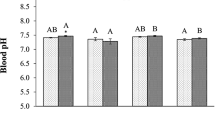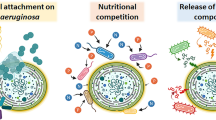Abstract
Background
Cobalt cyanide complexes often result when ore is treated with cyanide solutions to extract gold and other metals. These have recently been discovered in low but significant concentrations in effluents from gold leach operations. This study was conducted to determine the potential toxicity of cobalt-cyanide complexes to freshwater organisms and the extent to which ultraviolet radiation (UV) potentiates this toxicity. Tests were also conducted to determine if humic acids or if adaptation to UV influenced sensitivity to the cyanide complexes.
Methods
Rainbow trout (Oncorhynchus mykiss), Daphnia magna, and Ceriodaphnia dubia were exposed to potassium hexacyanocobaltate in the presence and absence of UV radiation, in the presence and absence of humic acids. Cyano-cobalt exposures were also conducted with C. dubia from cultures adapted to elevated UV.
Results
With an LC50 concentration of 0.38 mg/L, cyanocobalt was over a 1000 times more toxic to rainbow trout in the presence of UV at a low, environmentally relevant irradiance level (4 μW/cm2 as UVB) than exposure to this compound in the absence of UV with an LC50 of 112.9 mg/L. Toxicity was immediately apparent, with mortality occurring within an hour of the onset of exposure at the highest concentration. Fish were unaffected by exposure to UV alone. Weak-acid dissociable cyanide concentrations were observed in irradiated aqueous solutions of cyanocobaltate within hours of UV exposure and persisted in the presence of UV for at least 96 hours, whereas negligible concentrations were observed in the absence of UV. The presence of humic acids significantly diminished cyanocobalt toxicity to D. magna and reduced mortality from UV exposure. Humic acids did not significantly influence survival among C. dubia. C. dubia from UV-adapted populations were less sensitive to metallocyanide compounds than organisms from unadapted populations.
Conclusions
The results indicate that metallocyanide complexes may pose a hazard to aquatic life through photochemically induced processes. Factors that decrease UV exposure such as dissolved organic carbon or increased pigmentation would diminish toxicity.
Similar content being viewed by others
References
American Public Health Association. American Water Works Association. Water Pollution Control Federation (1989): Standard Methods for the Examination of Water and Wastewater, 17th ed, Washington DC
ASTM (2004): D 6994-04: Standard test method for determination of metal cyanide complexes in wastewater, surface water, groundwater and drinking water using anion exchange chromatography with UV detection. Annual Book of ASTM Standards, v. 11.02. American Society for Testing and Materials, West Conshohochen, PA
ASTM, Annual Book of ASTM Standards (1993): ASTM Guide E 729 — 88a, Standard Guide for Conducting Acute Toxicity Tests with Fishes, Macroinvertebrates, and Amphibians. American Society for Testing and Materials, Philadelphia, PA
Boening DW, Chew CM (1999): A critical review: General toxicity and environmental fate of three aqueous cyanide ions and associated ligands. Water, Air Soil Pollut 109, 67–79
Broderius SJ, Smith LL Jr (1980): Direct Photolysis of Hexacyanoferrate Complexes, EPA-600/3-80-003: Office of Research Development, US Environmental Protection Agency
Burdick GE, Lipschuetz M (1950): Toxicity of ferro-and ferrocyanide solutions to fish and determination of the cause of mortality. Transactions of the American Fisheries Society 78, 192
Calfee RD, Little EE (2003a): The effects of ultraviolet-B radiation on the toxicity of fire-fighting chemicals. Environ Toxicol Chem 1525–1531
Calfee RD, Little EE (2003b): Effects of a Fire-Retardant Chemical to Fathead Minnows in Experimental Streams. Env Sci Pollut Res 10, 296–300
Cao Y (1995): Competitive complexation of trace metals and dissolved humic acids. Environ Health Persp 103, 29–32
Dourdoroff P (1976): A Review of the Toxicity to Fish of Cyanides and Related Compounds. USEPA, EPA-600/3-76-038
Eisler R (1991): Cyanide Hazards to Fish, Wildlife, and Invertebrate: A Synoptic Review: Contaminant Hazard Review Report 23. US Department of Interior, Fish and Wildlife Service, 55pp
Fisher FB, Brown JS (1952): Colorimetric determination of cyanide is stack gas and waste water. Analytical Chemistry 24, 1440–1444
Flynn CM Jr, Haslem SM (1995): Cyanide Chemistry — Precious Metals Processing and Waste Treatment: Information circular 9429. US Bureau of Mines
George MW (2005): Gold, in Minerals Yearbook, Vol. I, Metals and Minerals, 〈http://minerals.er.usgs.gov/minerals/pubs/commodity/myb/〉
Goulden PD, Afghan BK, Brooksbank P (1972): Determination of nanogram quantities of simple and complex cyanides inwater. Analytical Chemistry, 44, 1845–1849
Grimes DJ, Johnson CA, Rye RO (1999): Accuracy of cyanide analysis: lessons from on-site analyses in the USGS mobile geochemical laboratory, and implications for heap leach regulatory and closure issues. In: Kosich D, Miller G (eds), Closure, Remediation and Management of Precious Metal Heap Leach Facilities. University of Nevada, Reno, pp 63–70
Haddad PR, Kalambaheti C (1991): Advances in ion chromatography: speciation of ug l−1 levels of metallo-cyanides using ion-interaction chromatography. Anal Chim Acta 250, 21–36
Johnson CA, Grimes DJ, Rye RO (2000): Fate of process solution cyanide and nitrate at three Nevada gold mines inferred from stable carbon and nitrogen isotope measurements. Transactions of the Institution of Mining and Metallurgy, Section C, vol 109, p C68–C78
Johnson CA, Leinz RW, Grimes DJ, Rye RO (2002): Photochemical changes in cyanide speciation in drainage from a precious metal ore heap. Environ Sci Technol 36, 840–845
Lean DRS (1997): Influence of ultraviolet-B radiation on aquatic ecosystems. In: Little E (ed), Environ Toxicol Risk Assess Vol 7. ASTM STP 333. American Society for Testing and Materials, West Conshohocken, Pennsylvania, pp 1–20
Little EE, Fabacher D (1996): Exposure of freshwater fish to simulated solar UVB radiation. In: Ostrander GK (ed), Techniques in Aquatic Toxicology. CRC Press, Boca Raton, FL, pp 141–158
MacCarthy P, Malcolm RL, Clapp CE, Bloom PR (1990): An introduction to soil humic substances. In: Humic Substances in Soil and Crop Science. American Society of Agronomy and Soil Science Society of America, Madison
Milosavljevic EB, Solujic L (2001): How to analyze for cyanide, in Cyanide: Social, Industrial and Economic Aspects In: Young CA, Twidwell LG, Anderson CG (eds), The Minerals, Metals & Materials Society, Warrendale PA, pp 117–131
Moran R (1999): Cyanide Uncertainties. Mineral Policy Center Issue Paper No. 1. Mineral Policy Center, Washington, DC
Skully NH, Lean DRS (1994): The attenuation of ultraviolet radiation in temperate lakes. Archiv für Hydrobiologie, Beiheft 43, 135–144
Smith A, Mudder T (1991): The Chemistry and Treatment of Cyanidation Wastes. Mining Journal Books Ltd., London, 345 pp
Smith A, Struhsacker DW (1988): Cyanide geochemistry and detoxification regulations. In: van Zyl D, Hutchison I, Kiel J (eds), Introduction to Evaluation, Design and Operation of Precious Metal Heap Leaching Projects. Society of Mining Engineers, Littleton CO, pp 275–292
Sokal RR, Rohlf FJ (1987): Biostatistics. Francise & Co, New York
US Environmental Protection Agency (1986): Quality Criteria for Water 1986. US EPA, Office of Water Regulations and Standard, Washington DC
Young CA (2001): Cyanide: Just the facts. In: Young CA, Twidwell LG, Anderson CG (eds), Cyanide: Social, Industrial and Economic Aspects. The Minerals, Metals & Materials Society, Warrendale PA, pp 97–116
Author information
Authors and Affiliations
Corresponding author
Rights and permissions
About this article
Cite this article
Little, E.E., Calfee, R.D., Theodorakos, P. et al. Toxicity of cobalt-complexed cyanide to Oncorhynchus mykiss, Daphnia magna, and Ceriodaphnia dubia . Env Sci Poll Res Int 14, 333–337 (2007). https://doi.org/10.1065/espr2007.03.400
Received:
Accepted:
Published:
Issue Date:
DOI: https://doi.org/10.1065/espr2007.03.400




